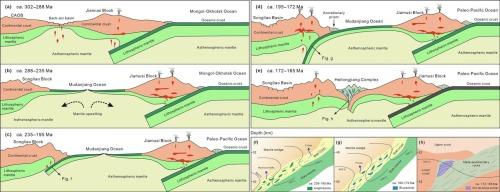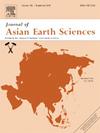Reconstructing the tectonic evolution of the Mudanjiang Ocean: Metamorphic insights from the Heilongjiang Complex, NE China
IF 2.4
3区 地球科学
Q2 GEOSCIENCES, MULTIDISCIPLINARY
引用次数: 0
Abstract
The Heilongjiang Complex in northeast China marks the suture zone recording the closure of the Mudanjiang Ocean between the Jiamusi and Songliao blocks. This study presents the first integrated analysis of garnet amphibolite, epidote-barroisite schist, and garnet-staurolite-mica schist from this complex, combining petrology, mineral chemistry, thermodynamic modelling, whole-rock geochemistry, and geochronology to constrain their metamorphic evolution and protolith origins. The garnet amphibolites display a peak mineral assemblage of garnet + amphibole + clinopyroxene + plagioclase + sphene + quartz, corresponding to pressure–temperature (P–T) conditions of 10.9–13.1 kbar and 712–760 °C. These conditions indicate an intermediate geothermal gradient, reflecting high-temperature metamorphism associated with early warm subduction of basaltic oceanic crust. E-MORB-like geochemical signatures and zircon U–Pb ages suggest a middle Permian oceanic crust protolith (ca. 272 Ma), with subsequent amphibolite-facies metamorphism occurring around 235 Ma. The epidote-barroisite schists are characterized by a peak assemblage of sodium amphibole + epidote + chlorite + phengite + sphene + rutile + quartz, and record peak P–T conditions of 14.9–16.4 kbar and 472–505 °C. These values correspond to a low geothermal gradient of 9–11 °C/km, consistent with mature, cold subduction environments. Their OIB-like geochemical affinities and zircon ages of 244–241 Ma indicate a basaltic seamount origin within the Mudanjiang Ocean during the middle Triassic. The garnet-staurolite-mica schists record a clockwise P–T path, marked by decompression coupled with heating from blueschist- to amphibolite-facies conditions. This thermal evolution supports a diapiric exhumation model into the warm middle to lower crust of the overriding plate, rather than exhumation along a cold subduction channel, and is interpreted as a response to the collision between the Jiamusi and Songliao blocks. Integrating these findings with previous research, we propose a revised tectonic model for the Mudanjiang Ocean. Its initial opening occurred in a back-arc extensional setting in the western Jiamusi Block, driven by westward subduction of the Mongol–Okhotsk Ocean during the latest Carboniferous to Permian. Final closure and continental amalgamation took place during the late Triassic to middle Jurassic, resulting from westward subduction and compression of the Paleo-Pacific Plate. The Mudanjiang Ocean is interpreted as a branch of the Panthalassa or Paleo-Pacific Ocean, with an estimated lifespan of approximately 116 million years, spanning from the early Permian to middle Jurassic (ca. 288–172 Ma).

重建牡丹江洋的构造演化:来自黑龙江杂岩的变质作用
中国东北的黑龙江杂岩标志着木木斯和松辽地块之间牡丹江洋闭合的缝合带。本文首次结合岩石学、矿物化学、热力学模型、全岩地球化学和地质年代学,对该杂岩中的石榴石角闪岩、绿石-钡石片岩和石榴石-星云母片岩进行了综合分析,以限制其变质演化和原岩起源。石榴石角闪岩的峰矿物组合为石榴石+角闪洞+斜辉石+斜长石+榍石+石英,对应的压力-温度(P-T)条件为10.9 ~ 13.1 kbar,温度为712 ~ 760℃。这些条件表明了一个中等地温梯度,反映了与玄武岩洋壳早期热俯冲有关的高温变质作用。类似e- morb的地球化学特征和锆石U-Pb年龄表明中二叠世洋壳原岩(约272 Ma),随后的角闪岩相变质作用发生在235 Ma左右。绿石-钡石片岩的峰组合为钠角闪洞+绿石+绿泥石+云母+榍石+金红石+石英,峰值P-T条件为14.9 ~ 16.4 kbar,温度为472 ~ 505℃。这些值对应于9-11°C/km的低地温梯度,与成熟的冷俯冲环境相一致。它们的地球化学亲和度和锆石年龄(244 ~ 241 Ma)表明中三叠世牡丹江洋的玄武岩海山成因。石榴石-星黄岩-云母片岩的P-T路径为顺时针方向,表现为蓝片岩-角闪岩相条件下的减压和升温。这种热演化支持了上覆板块温暖的中下地壳的底辟掘出模式,而不是沿着冷俯冲通道掘出,并被解释为对佳木斯和松辽地块碰撞的响应。结合前人的研究成果,提出了牡丹江洋的修正构造模型。在晚石炭世—二叠世蒙古—鄂霍次克洋向西俯冲的作用下,其初始张开发生在佳木斯地块西部的弧后伸展背景下。在晚三叠世至中侏罗世期间,古太平洋板块向西俯冲和挤压导致了最终的闭合和大陆合并。牡丹江洋被解释为泛海(Panthalassa)或古太平洋(palepacific Ocean)的一个分支,估计其寿命约为1.16亿年,跨越早二叠世至中侏罗世(约288-172 Ma)。
本文章由计算机程序翻译,如有差异,请以英文原文为准。
求助全文
约1分钟内获得全文
求助全文
来源期刊

Journal of Asian Earth Sciences
地学-地球科学综合
CiteScore
5.90
自引率
10.00%
发文量
324
审稿时长
71 days
期刊介绍:
Journal of Asian Earth Sciences has an open access mirror journal Journal of Asian Earth Sciences: X, sharing the same aims and scope, editorial team, submission system and rigorous peer review.
The Journal of Asian Earth Sciences is an international interdisciplinary journal devoted to all aspects of research related to the solid Earth Sciences of Asia. The Journal publishes high quality, peer-reviewed scientific papers on the regional geology, tectonics, geochemistry and geophysics of Asia. It will be devoted primarily to research papers but short communications relating to new developments of broad interest, reviews and book reviews will also be included. Papers must have international appeal and should present work of more than local significance.
The scope includes deep processes of the Asian continent and its adjacent oceans; seismology and earthquakes; orogeny, magmatism, metamorphism and volcanism; growth, deformation and destruction of the Asian crust; crust-mantle interaction; evolution of life (early life, biostratigraphy, biogeography and mass-extinction); fluids, fluxes and reservoirs of mineral and energy resources; surface processes (weathering, erosion, transport and deposition of sediments) and resulting geomorphology; and the response of the Earth to global climate change as viewed within the Asian continent and surrounding oceans.
 求助内容:
求助内容: 应助结果提醒方式:
应助结果提醒方式:


